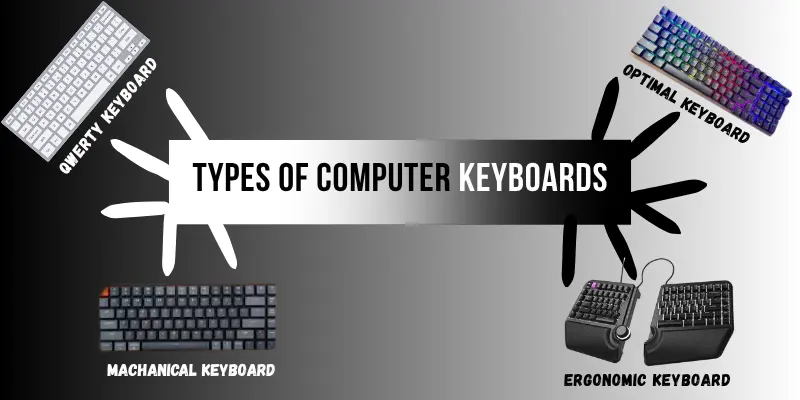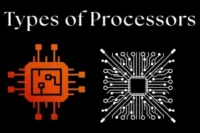The Ultimate Overview of Keyboard Types: From Mechanical to Virtual
Published: 4 Aug 2025
Keyboards are available in a variety of styles to satisfy a wide range of user requirements, from traditional mechanical devices to advanced virtual interfaces. Mechanical keyboards are known for their tactile feedback and durability, but membrane keyboards are quieter and less expensive alternatives. Flexible silicone keyboards are ideal for those who want portability. They may be readily rolled up and transported. Furthermore, virtual keyboards that project keys onto a flat surface offer novel options for touch-enabled devices.
If you are building your ideal workspace, pairing your keyboard with the right type of mouse can greatly improve comfort and productivity. In this post, we will go over the many types of keyboards so you can choose the one that best meets your needs.
What is a Keyboard?
A keyboard is an input device that allows you to type and control your computer. It includes keys for letters, numbers, symbols, and functions. Keyboards can be wired or wireless and come in a variety of configurations. They are vital for communication, programming, and gaming. If you’re also curious about complete computing setups, you might like our guide on the types of laptops.

Types of Keyboard
Keyboards come in various types based on design, technology, and usage. Here are the main types:
|
1. QWERTY Keyboard
This is the most frequent and traditional keyboard layout. It is named after the first six keys of the keyboard (QWERTY). The design was influenced by early typewriters. The keys were constructed in such a way that the most commonly used letters are spaced apart to prevent key jamming. Christopher Latham Sholes created the design in the early 1870s, and it continues to be used today. It contains a variety of keys, including alphabetic, special, function, and modifier keys.
2. Optimal Keyboard
Optical Keyboards detect keystrokes using light-based optical switches rather than standard mechanical or membrane switches. It offers faster response times, more durability, and less wear and tear, making it ideal for gaming and high-speed typing. Unlike mechanical keyboards, it works without physical contact, increasing durability and dependability.
3. Mechanical Keyboard
Mechanical keyboards are quite durable. Each key is equipped with an independent mechanical switch or spring. This increases their durability while also making them easier to repair. They are popular for their distinct keypress sound and sensitivity. However, they cost more than ordinary keyboards.
4. Gaming Keyboard
A Gaming Keyboard is a special keyboard made for playing games. It has fast response times, colorful lights, and buttons you can set up the way you want. Many gaming keyboards use special switches to make typing quick and easy. They also have features like anti-ghosting, N-key rollover, and macros to help gamers play better.
5. Ergonomic Keyboard
An Ergonomic Keyboard is designed to reduce pressure on your hands and wrists while typing. It often has a curved or split layout to keep your hands in a natural position, which helps to avoid discomfort or injuries such as wrist pain. These keyboards are great for people who type for long hours, such as office workers and writers.
How to Choose the Right Type of Keyboard?
Choosing the right keyboard depends on your needs, preferences, and usage. Here are some key factors to consider:
1. Purpose of Use
- Gaming: Go for a Gaming Keyboard with mechanical or optical switches, RGB lighting, and programmable keys.
- Typing/Office Work: Choose an Ergonomic Keyboard or Mechanical Keyboard with comfortable key feedback.
- Casual Use: A Membrane Keyboard is affordable and sufficient for basic tasks.
2. Switch Type
- Mechanical Switches: Offer tactile feedback and durability (best for gamers and typists).
- Membrane Switches: Quiet and budget-friendly but less responsive.
- Optical Switches: Fast response and durable, great for gaming.
3. Size & Layout
- Full-Size Keyboard: Includes a number pad, ideal for office work.
- Tenkeyless (TKL) Keyboard: Compact, no number pad, good for saving space.
- 60% Keyboard: Ultra-compact, lacks function and arrow keys, ideal for minimalists.
4. Ergonomics & Comfort
- If you type for long hours, an Ergonomic keyboard with a split or curved design can help reduce hand strain..
5. Connectivity
- Wired Keyboards: Offer stable connections and lower latency.
- Wireless/Bluetooth Keyboards: Provide flexibility and portability, but may have slight input lag.
6. Extra Features
- Backlit Keys/RGB Lighting: Useful for gaming and working in low-light environments.
- Macro Keys & Customization: Important for gaming and professional use.
- Water Resistance: Helps prevent damage from spills
Common Mistakes to Avoid When Buying a Keyboard
When selecting a Keyboard, it is critical to stay away from frequent mistakes that may result in disappointment or extra expenses. Here are the primary dangers to avoid:
- Choosing the Wrong Type: Select a keyboard that fits your needs, whether for gaming, typing, or ergonomic comfort.
- Ignoring Key Switches: Mechanical, membrane, and optical switches offer different typing experiences, and pick the right one.
- Overlooking Size & Layout: Ensure the keyboard’s size (full-size, TKL, or 60%) suits your workspace and usage.
- Focusing Only on Price: Cheap keyboards may lack durability, while expensive ones may have unnecessary features.
- Skipping Connectivity Needs: Decide between wired and wireless based on responsiveness, portability, and convenience.
Conclusion
So, in this article, we’ve discussed the different types of keyboards in detail. For gaming, I recommend a mechanical keyboard due to its speed and durability. For office use, a quiet and comfortable membrane keyboard might be a better choice. Ultimately, the best keyboard depends on your needs and preferences. Have you found the perfect keyboard for you? Let us know in the comments!
Frequently Asked Questions [FAQs]
Have questions about the keyboard? Here are some of the most frequently asked questions to help you better understand the topic:
Mechanical keyboards are ideal for gaming due to their quick response rates and durable switches. Many gaming keyboards include RGB lights and customizable keys to improve gameplay. If you like quieter keys, an optical keyboard is an excellent choice.
A Wired keyboard connects directly to your computer, ensuring a solid and lag-free experience. A Wireless keyboard utilizes Bluetooth or USB receivers, providing greater flexibility and portability. Wireless keyboards may experience a little input delay and require battery charging or replacement.
An ergonomic keyboard is intended to relieve wrist and hand strain and promote a natural typing position. It is perfect for office workers, writers, and anyone who spends long hours typing. These keyboards frequently have a split or curved layout for added comfort.
First, turn off and unplug your keyboard. Use compressed air or a soft brush to remove dust from between the keys. For deeper cleaning, wipe the keys with a damp cloth or use a cotton swab with isopropyl alcohol.
A chiclet keyboard has flat, square-shaped keys with rounded corners that are spaced apart for a clean appearance. It is widely seen in laptops and provides a quieter, low-profile typing experience.

- Be Respectful
- Stay Relevant
- Stay Positive
- True Feedback
- Encourage Discussion
- Avoid Spamming
- No Fake News
- Don't Copy-Paste
- No Personal Attacks

- Be Respectful
- Stay Relevant
- Stay Positive
- True Feedback
- Encourage Discussion
- Avoid Spamming
- No Fake News
- Don't Copy-Paste
- No Personal Attacks





